23 Apr Blessingways
by Rachel Voigt and Kate Saumweber Hogan
What is a Blessingway?
A blessingway was traditionally a Navajo Ritual, a sacred fertility rite, created to spiritually support and empower the new mother for her journey of birthing and motherhood. Not only used around birth, the blessingway can also celebrate women at a time in a woman’s life when she is experiencing some type of change or transition, such as menarche, menopause, or engagement. In recent times, the blessingway as been loosely adapted from its Navajo beginnings to create a woman-centered celebration. The emphasis in a blessingway is on the supporting the expectant mother – her strength, her beauty, her dignity, her womanhood, her divine procreative powers, her metamorphosis as she goes through the creative process of bringing new life into this world.
Blessingways are similar to baby showers in that they celebrate the pregnancy and the growth of a family but they are different in several ways. Baby showers tend to have a focus on lighthearted fun, jokes, and many, many gifts for babies. In comparison, blessingways focus more on the strength of the mother and celebrate her new phase in life. There is an emphasis on the bond between the various women in her life and the importance of their support as she moves towards the birth and the postpartum period. Blessingways are not a time to share horror stories or fears, but a time to share positive and uplifting words of support and encouragement. It is a time to welcome the power and strength that is already intrinsic in women’s bodies, and to shower the mother with love and support.
What do you do at a Blessingway?
There are many things that can be done at a blessingway. Not all practices need to be incorporated into each ceremony and some can be mixed into traditional baby showers. Take a few aspects that you and the pregnant mama are comfortable with and use them to celebrate her journey.
Setting a Sacred Space:
On arrival guests should strive to intentionally leave all stresses of the day behind and focus on support the pregnant mama. This can be done by having a bowl of warm water with lavender essential oil &/or lavender springs in it for women to dip their hands in or by diffusing lavender essential oil in the room.
Candle Introductions:
Have each woman light a candle and then introduce herself by saying “I am (name), daughter of (name), daughter of (name), and I am mother of (name), grandmother of (name)”. This is a great way to invite the female lineage into the circle and to capture the power of female traditions passed on generationally.
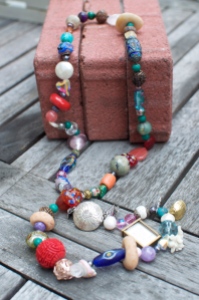 Beading Ceremony:
Beading Ceremony:
Either the host can have an assortment of beads or buttons at the ceremony or each guest can bring a bead (or a pair of beads for symmetry) to share. Pass a small bowl or jar around the group and have each woman place her bead in it while saying a wish or hope for the mother and baby. Once all guests have shared their beads, the host can string it into a bracelet or necklace for mama that she can wear or have near her in her birthing time. Some women also like to turn these beads into lovely mobiles for their babies.
Bracelet Tying:
Sit or stand in a circle, pass around a ball of yarn, and loosely wrap the yarn around each person’s wrist or ankle. As the yarn is passed, the group is literally creating a web of support. After everyone is connected, they can help each other cut the yarn and tie it on each other (including the pregnant mom) as a bracelet. It is tradition to wear this bracelet until the mother gives birth. Seeing the yarn every day gives each person in the group an opportunity to send love and blessings to the mother as she gets closer to her birthing time. When the news is shared of her little one’s arrival, then the yarn can be cut off, like a symbolic cutting of the umbilical cord. The yarn symbolizes the support that these friends are offering the mother. This activity is often done at the beginning (and can be done as each person introduces themselves), or to close the circle at the end (and could be accompanied with each person sharing a strength or quality that they know the mother will serve her in her birthing space and/or motherhood journey, incorporating into this web the mother’s gifts that already make her such a wonderful mother).
Make an Altar: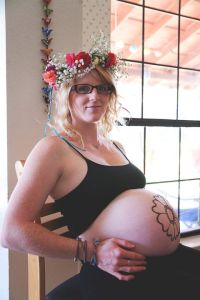
An altar is a place to set good intentions and things that are important for the mother at the time of the birth. If the mother would like this, in the invitation the host can ask guests to bring something for the labor altar, such as a figurine, symbol, image, framed poem, candles, a necklace, rock, whatever seems appropriate.
Flower Crown:
Flower crowns can connect women to the earth, can be beautiful, can be a sign of respect for her as the birthing woman, and can simply be fun. Flower crowns can be made before the blessingway or as a part of the ceremony.
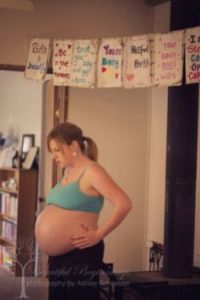 Prayer Flags and/or Affirmations:
Prayer Flags and/or Affirmations:
Each guest and the mother can make prayer flags or write out birth affirmations that the mother can hang some where within eye sight during labor. She could also hang these in the baby’s room as he or she grows. If each guest had stated a hope/wish for the mom during the beading ceremony, the host could also write those on the prayer flags.
Candle Gifts:
Sometimes a candle is lit as each person introduces themselves and their maternal lineage. Each guest can take home a candle and can light it when the mama is in labor, or after the baby arrives to honor her birthing and new mother time.
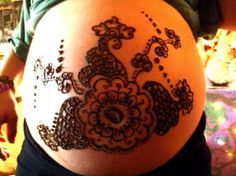 Henna her Belly:
Henna her Belly:
This is a very ancient practice that asks women to slow down and take the time to show love and respect to the pregnant mama’s belly and the baby that is inside. It is a way to honor and decorate the pregnant body, and each guest can also get a little henna on their hand or foot to artistically tie them to the mother’s body.
Laying of Hands:
Have each guest place their hands on the pregnant woman’s belly (if she is comfortable with this) and sing a song, say a prayer or say a blessing in unison.
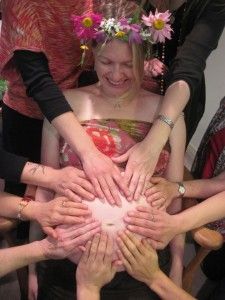 Foot Washing, Massage, or Hair Braiding:
Foot Washing, Massage, or Hair Braiding:
These rituals honor the mother’s physical body, offering her some relaxation and loving touch. This allows the mother to practice relaxing into the hands of another and openly accepting the kind of nurturing that she will need during labor. Washing is also a form of cleansing in preparation for the journey into motherhood. And as the mother approaches the threshold into birth, these rituals can bless her body.
Poems and Blessings:
The host can ask guests to bring a poem, blessing, or scripture passage to read and leave with the mother. Sometimes mothers will have these with them during their birthing time for their birth team to read to them, bringing them extra strength and support. Twin Cities Midwifery has an ever growing list of wonderful blessings and poems to consider bringing to a blessingway.
Food:
Often food and drink are part of the celebration, allowing for some unstructured time for the participants to be present together.
For more information please see “Blessingways: A Guide to Mother-Centered Baby Showers” by Shari Maser; there is a copy available to be borrowed from the Twin Cities Midwifery library.
All photos taken from Pinterest


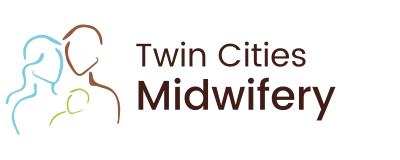

Blessingway Poetry and Readings | Twin Cities Midwifery Blog
Posted at 11:45h, 23 April[…] Looking for more ideas on what to include at a Blessingway? Check out our post on that very topic to learn more. […]
Birth Art and Inspirational Images | Twin Cities Midwifery Blog
Posted at 05:07h, 13 October[…] displayed in the new baby’s room or in the birthing space. It can also be made as a part of a Blessingway if a mother would like that. Here, are some examples of artwork depicting a still developing […]